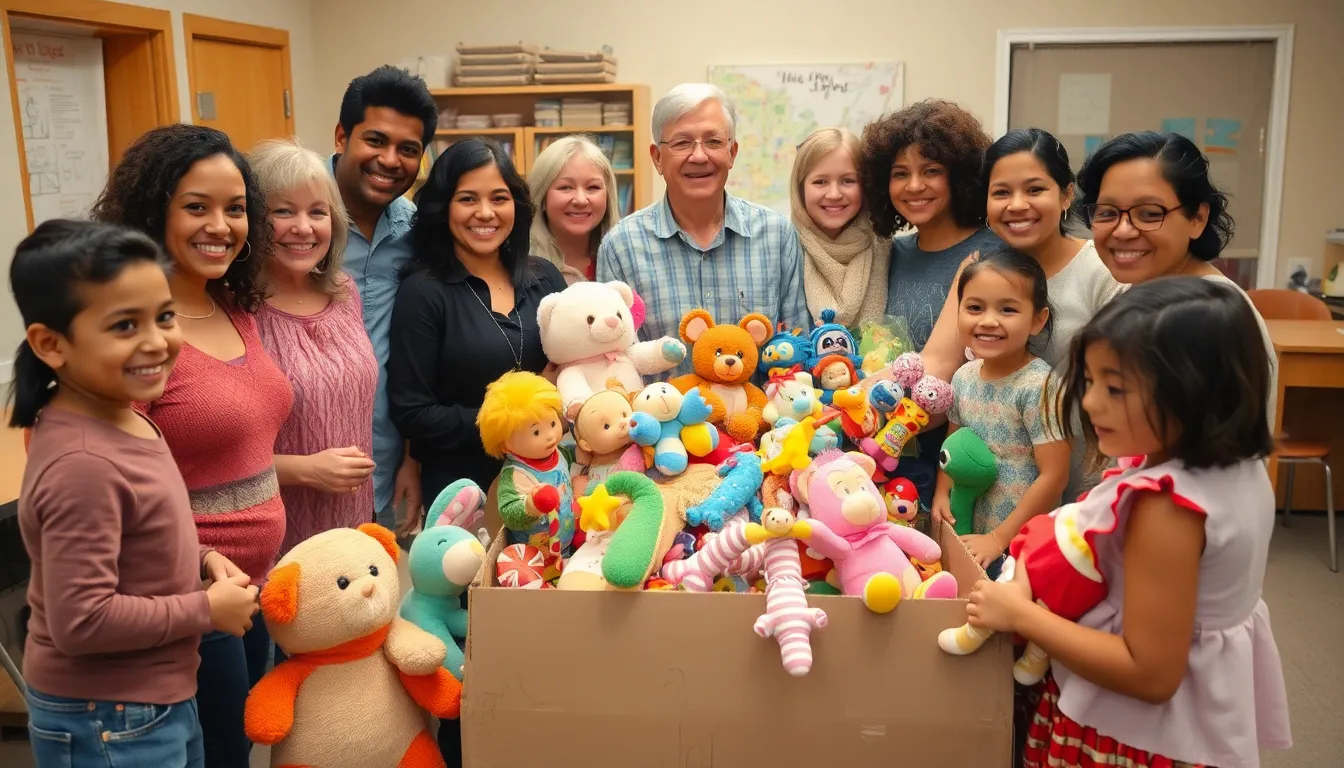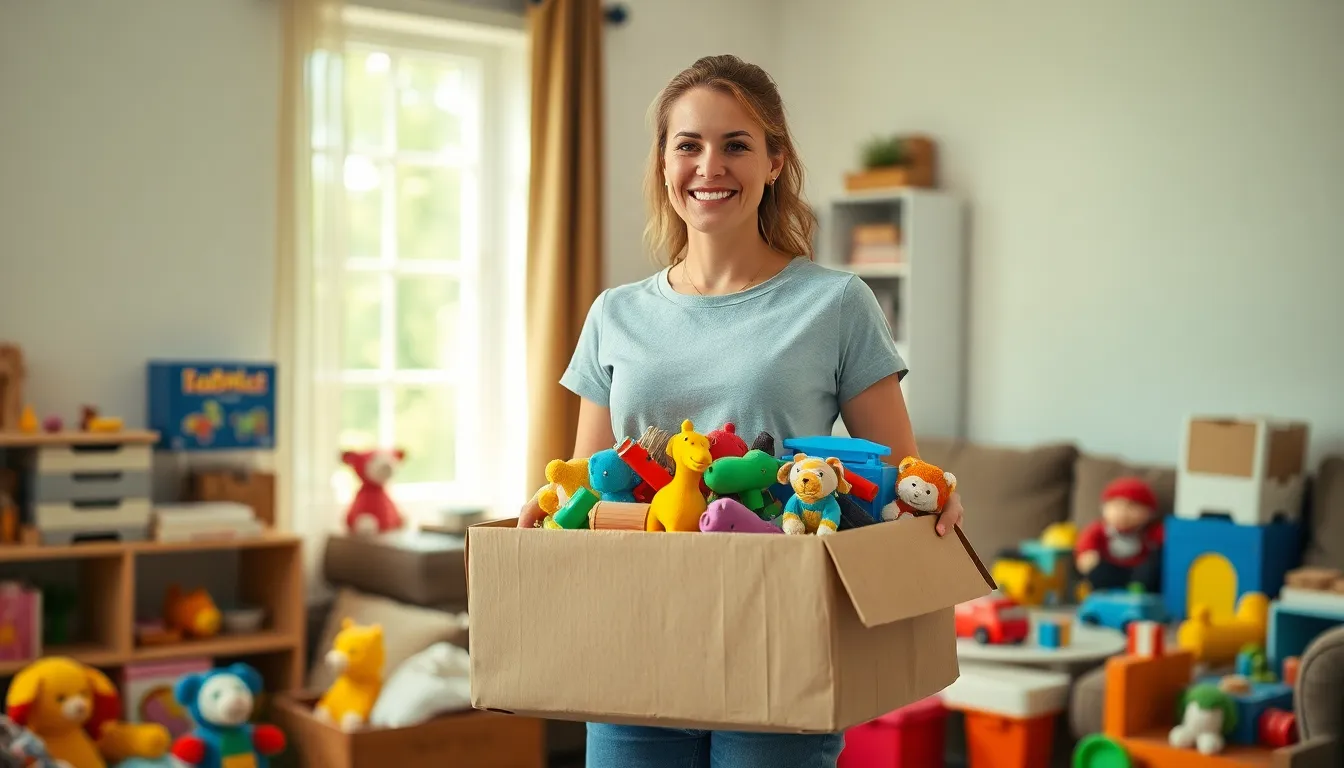Got a mountain of used toys taking over your living room? You’re not alone! Many parents find themselves buried under a colorful avalanche of action figures and stuffed animals. Instead of letting them gather dust or plotting a dramatic toy rescue mission, why not give them a second chance at life? Donating those pre-loved toys can bring joy to other kids while freeing up your space for more important things—like that new coffee maker you’ve been eyeing.
Table of Contents
ToggleOverview of Donating Used Toys
Donating used toys benefits both the giver and receiver. Local charities welcome toy donations to support children in need. Organizations like Goodwill and Salvation Army provide collection points for used toys. Many children’s hospitals also accept toy donations, ensuring hospitalized kids have new sources of comfort and entertainment.
Some community centers organize toy drives, which allow families to donate gently used toys. Participating in these events supports local children while fostering community spirit. Schools often collaborate with local non-profits to gather toys during holiday seasons, encouraging families to donate.
Checking the condition of toys is essential before donating. Toys should be clean, functional, and free from broken pieces. Donors must ensure that items, such as stuffed animals or games, meet safety standards to protect the well-being of children.
Specific items often excluded from donations include plush toys over a set size, toys with small pieces or choking hazards, and clothing. Many organizations provide guidelines on acceptable items to streamline the donation process.
Discovering donation locations can be straightforward. Online searches for “toy donation centers near me” yield various options. Local Facebook groups may also host discussions about nearby donation opportunities, helping parents connect with others in their community.
Utilizing donated toys fosters a sense of sharing and generosity. Supporting local charities through toy donations creates a positive impact on families transitioning into challenging situations. Contributing to this cause enriches children’s lives while making room for new experiences at home.
Local Donation Options

Finding local donation options for used toys is straightforward. Numerous organizations and community centers accept toys that can brighten a child’s day.
Nonprofit Organizations
Nonprofit organizations frequently seek toy donations to support families in need. Goodwill and Salvation Army often welcome gently used toys, as proceeds from sales help fund various programs. They provide a convenient drop-off process at local stores and collection centers. Other options include local shelters or charities that focus on children, where toys can directly reach those who need them most. Sometimes, children’s hospitals accept toys. These donations can offer comfort to kids undergoing treatment, making playtime more joyful. Always check donation guidelines to ensure toys meet safety standards.
Community Centers
Community centers play a vital role in promoting local donations. Many centers host toy drives, collecting toys for distribution during holiday seasons or special events. Engaging with neighbors through community initiatives fosters a sense of togetherness. Contacting local community centers can provide information on upcoming events or ongoing collections. Often, schools partner with these centers in efforts to inspire families to contribute. School campaigns can make donating a fun activity, nurturing kindness and empathy in young children. Donating through community centers helps ensure toys reach local families facing challenges, further strengthening the community fabric.
Online Resources for Donations
Numerous online resources simplify the process of donating used toys. Utilizing these platforms connects donors with local organizations that appreciate toy contributions.
Donation Locators
Donation locators serve as invaluable tools. Websites like Donation Town or the National Charity Report provide lists of nearby organizations accepting toy donations. Users input their zip code, receiving information on appropriate charities in their area. Many local nonprofits also maintain updated online directories, ensuring access to donation drop-off points. Finding a convenient location encourages parents to take part in donation efforts, enriching the community and supporting those in need.
Social Media Groups
Social media groups play a vital role in facilitating toy donations. Platforms like Facebook and Nextdoor host numerous community groups dedicated to exchanges and donations. These groups enable parents to post about available toys while connecting with families who may benefit. Members often see posts requesting donations for specific organizations, furthering visibility and encouraging participation. Engaging with these groups not only helps declutter homes, but also fosters a sense of community and shared purpose among local residents.
Preparing Toys for Donation
Preparing toys for donation ensures they bring joy to new children. Proper care enhances their acceptance and usability.
Cleaning and Sorting
First, thoroughly clean each toy to remove dust and harmful germs. Washing plush toys in a washing machine on a gentle cycle often works best. Inspect plastic toys for visible wear; any broken pieces require removal. While sorting, group toys by type, like games, dolls, or building sets. This organized approach simplifies the donation process. Check for any missing parts; only donate complete sets. Avoid donating items that are stained, damaged, or have small parts that pose choking hazards. By following these steps, parents contribute safe and enjoyable toys to children in need.
Packaging Guidelines
Choose sturdy boxes or bags for packaging donations securely. Label each box with the contents for easy identification. Consider wrapping fragile items with bubble wrap or packing paper to prevent damage during transport. Ensure each container remains manageable; limit weight to what one person can comfortably carry. Use bags made from recycled materials when possible to promote sustainability. Tape boxes securely to keep items from falling out. Encourage children to help with packaging to foster a sense of sharing. Following these guidelines makes the donation process efficient and respectful of the recipient’s needs.
Benefits of Donating Used Toys
Donating used toys creates a positive impact on the lives of children. First, it provides an opportunity for children in need to receive toys that bring joy, fostering happiness during difficult times. Second, such donations help reduce waste, promoting environmental sustainability by keeping toys out of landfills.
Additionally, donating toys enables families to declutter their homes. Parents often feel relieved when they let go of unused items, creating a more organized living space. Simplifying belongings can also lead to a more peaceful environment.
Moreover, participating in toy donations enhances community spirit. Families feel connected when they support local charities and participate in toy drives organized by community centers or schools. Building relationships within the community encourages further acts of kindness and support.
For donors, this act of giving provides a sense of fulfillment. Knowing that a used toy might become a cherished possession for another child evokes emotions of joy and satisfaction. This fulfillment often inspires continuous generosity, fostering a cycle of giving.
Charitable organizations also benefit from toy donations. Local charities like Goodwill and Salvation Army rely on these contributions to support outreach programs for families. During holiday seasons, such donations become critical for charitable initiatives aimed at bringing happiness to children during celebrations.
Lastly, toy donations can be tax-deductible. This financial benefit encourages more families to consider donating their gently used toys. Tax benefits can serve as additional motivation for contributing to local charities.
In sum, the advantages of donating used toys extend to donors, recipients, and the community at large, creating a ripple effect of positivity and support.
Donating used toys is a simple yet impactful way to make a difference in the lives of children and strengthen community ties. Parents can easily find local organizations eager to accept these donations. By ensuring toys are clean and in good condition, they can spread joy to those in need.
Participating in toy drives or connecting with local charities not only helps declutter homes but also fosters a spirit of generosity. Each donation contributes to a cycle of kindness that enriches the entire community. Embracing this practice can lead to lasting positive change for both donors and recipients.



